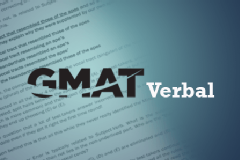Covers entire syllabus in 3 months.
Here is the more information.
Syllabus: The GMAT exam consists of four sections: Analytical Writing Assessment (AWA), Integrated Reasoning (IR), Quantitative Reasoning (Quant), and Verbal Reasoning (Verbal). Each section tests specific skills and knowledge areas. Here's an overview of the syllabus:
-
Analytical Writing Assessment (AWA):
- Analysis of an Argument: You will be presented with an argument and required to analyze its reasoning, structure, and evidence.
-
Integrated Reasoning (IR):
- Multi-Source Reasoning: You will evaluate information from multiple sources (text, charts, tables) to answer questions.
- Graphics Interpretation: You will interpret data from graphs and select the correct answer option.
- Two-Part Analysis: You will solve complex problems by evaluating multiple components.
- Table Analysis: You will analyze and sort data in a table format to answer questions.
-
Quantitative Reasoning (Quant):
- Problem Solving: You will solve quantitative problems involving arithmetic, algebra, geometry, and data analysis.
- Data Sufficiency: You will analyze problems and determine the sufficiency of provided data to solve them.
-
Verbal Reasoning (Verbal):
- Reading Comprehension: You will read passages and answer questions related to the passage's content, structure, and purpose.
- Critical Reasoning: You will evaluate arguments and draw conclusions based on their reasoning.
- Sentence Correction: You will identify errors in sentences and select the appropriate correction.
Study Plan: Creating a structured study plan can help you stay organized and make the most of your preparation time. Here's a suggested study plan:
-
Familiarize Yourself with the Exam:
- Understand the exam format, question types, and scoring criteria.
- Review sample questions and practice tests to gauge your initial strengths and weaknesses.
-
Set a Target Score:
- Determine your target GMAT score based on your target business schools' requirements.
- Research the average GMAT scores accepted by your desired schools to set realistic goals.
-
Identify Strengths and Weaknesses:
- Take a diagnostic test to identify your strengths and weaknesses in each exam section.
- Analyze your performance to prioritize your study efforts and allocate more time to weaker areas.
-
Develop a Study Schedule:
- Divide your study time into manageable sessions, considering your daily commitments.
- Allocate more time to sections or topics where you need improvement.
- Include regular practice tests to track your progress.
-
Study Materials and Resources:
- Gather reliable study materials, such as official GMAT guides, question banks, and online resources.
- Consider joining a GMAT prep course or using online platforms that offer comprehensive study materials and practice tests.
-
Content Review:
- Review fundamental concepts and skills required for each section (AWA, IR, Quant, Verbal).
- Focus on topics and question types that you find challenging.
-
Practice, Practice, Practice:
- Solve a variety of practice questions and timed mock tests to enhance your speed and accuracy.
- Analyze your mistakes and learn from them.
- Simulate exam-like conditions during practice tests to build endurance.
-
Test-Taking Strategies:
- Learn effective strategies for managing time, eliminating answer choices, and approaching different question types.
- Develop a personal strategy for each section based on your strengths and weaknesses.
-
Monitor Your Progress:
- Regularly assess your progress by taking full-length practice tests.
- Analyze your results and identify areas that still need improvement.
- Adjust your study plan as needed based on your performance.
-
Exam Day






